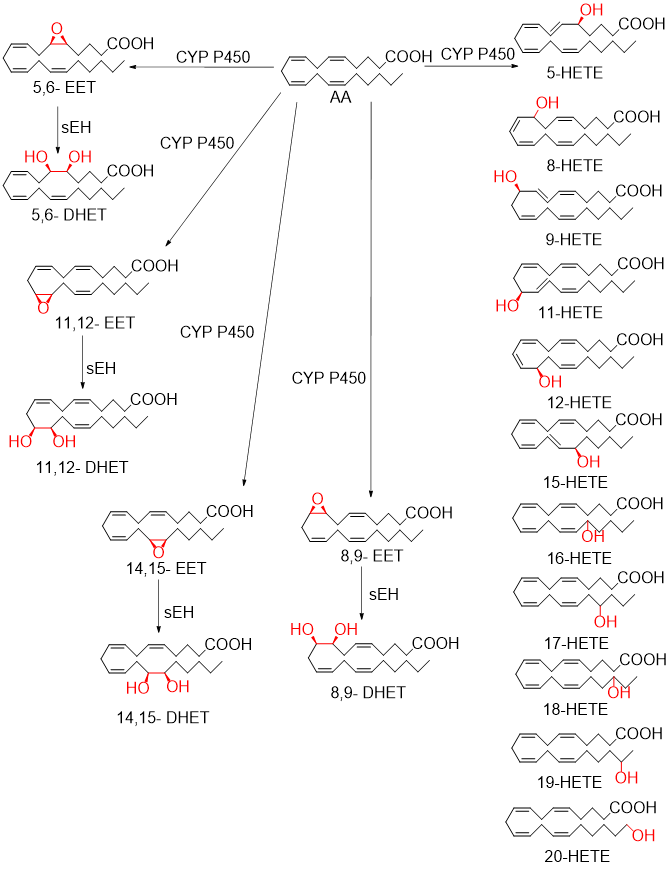Difference between revisions of "Cytochrome P450"
(Created page with "* Transformation of AA to 20-HETE * Transformation of AA to 9-HETE * Transformation of AA to 5,6-E...") |
|||
| Line 1: | Line 1: | ||
| + | [[Welcome to the In-Silico Model of Cutaneous Lipids Wiki | Return to overview]] | ||
| + | |||
| + | The superfamily of CYP P450 enzymes is encoded by a minimum of 57 genes in humans (Nelson et al., 2004, Nebert et al., 2002). This varied class possess epoxygenase and hydrolase activity and can convert PUFAs such as AA into cis-epoxyeicosatrienoic acid (EET), dihydroxyeicosatetraenoic acid (DHET) and HETEs (Morisseau et al., 2013, Oliw, 1994). These reactions are redox coupled, include the activation of molecular oxygen and depending on the isoform the reactions, are NADPH independent or dependant. The reactions are typically performed by the microsomal CYP P450 isoforms. | ||
| + | |||
| + | 1.1.2.4 Epoxygenation pathway | ||
| + | The genes CYP2C and CYP2J encode subfamilies of proteins which perform Olefin epoxidation reactions on AA, to generate epoxyeicosatrienoic acids (EETs) (Wu et al., 1996, Zeldin, 2001). This reaction is NADPH dependant and involves the electrophilic addition of oxygen to an alkene, and due to the four double bonds of AA, four regioisomeric EETs are formed (5,6-, 8,9-, 11,12-, and 14,15-EET). | ||
| + | Due to the epoxide group EETs are unstable and are hydrolysed by the protein soluble epoxide hydrolase (sEH) (Morisseau et al., 2013, Capdevila et al., 2002, Spector, 2009, Zeldin, 2001). This reaction generates dihydroxyeicosatrienoic acids (DHETs) by the addition of two hydrogens and one oxygen molecule across the epoxide ring. This protein is located at the microsomal and ER membranes. | ||
| + | |||
| + | 1.1.1.1 Hydroxylation pathway | ||
| + | In addition, the CYP4A and CYP4F genes encode subfamilies of CYP P450 which convert PUFA into mono-hydroxy fatty acids by (Lasker et al., 2000, Powell et al., 1998). This is performed by a bis-allylic oxidation followed by an acid-catalysed rearrangement to the corresponding cis-trans dienols. This results in the generation of six regioisomeric HETEs (5-, 8-, 9-, 11-, 12- and 15-HETE) which contain cis, trans-conjugated dienol functionality. Furthermore, monohydroxy fatty acids can be generated via an omega oxidation, which involves oxidation at the terminal or the penultimate carbon (Harder et al., 1995). This reaction results in the formation of 16-, 17-, 18-, 19- and 20-HETE. | ||
| + | |||
| + | [[File:CYP.png]] | ||
| + | |||
| + | ''''' Reactions''''' | ||
* [[Transformation of AA to 20-HETE |Transformation of AA to 20-HETE]] | * [[Transformation of AA to 20-HETE |Transformation of AA to 20-HETE]] | ||
* [[Transformation of AA to 9-HETE |Transformation of AA to 9-HETE]] | * [[Transformation of AA to 9-HETE |Transformation of AA to 9-HETE]] | ||
Revision as of 08:17, 22 May 2019
The superfamily of CYP P450 enzymes is encoded by a minimum of 57 genes in humans (Nelson et al., 2004, Nebert et al., 2002). This varied class possess epoxygenase and hydrolase activity and can convert PUFAs such as AA into cis-epoxyeicosatrienoic acid (EET), dihydroxyeicosatetraenoic acid (DHET) and HETEs (Morisseau et al., 2013, Oliw, 1994). These reactions are redox coupled, include the activation of molecular oxygen and depending on the isoform the reactions, are NADPH independent or dependant. The reactions are typically performed by the microsomal CYP P450 isoforms.
1.1.2.4 Epoxygenation pathway The genes CYP2C and CYP2J encode subfamilies of proteins which perform Olefin epoxidation reactions on AA, to generate epoxyeicosatrienoic acids (EETs) (Wu et al., 1996, Zeldin, 2001). This reaction is NADPH dependant and involves the electrophilic addition of oxygen to an alkene, and due to the four double bonds of AA, four regioisomeric EETs are formed (5,6-, 8,9-, 11,12-, and 14,15-EET). Due to the epoxide group EETs are unstable and are hydrolysed by the protein soluble epoxide hydrolase (sEH) (Morisseau et al., 2013, Capdevila et al., 2002, Spector, 2009, Zeldin, 2001). This reaction generates dihydroxyeicosatrienoic acids (DHETs) by the addition of two hydrogens and one oxygen molecule across the epoxide ring. This protein is located at the microsomal and ER membranes.
1.1.1.1 Hydroxylation pathway In addition, the CYP4A and CYP4F genes encode subfamilies of CYP P450 which convert PUFA into mono-hydroxy fatty acids by (Lasker et al., 2000, Powell et al., 1998). This is performed by a bis-allylic oxidation followed by an acid-catalysed rearrangement to the corresponding cis-trans dienols. This results in the generation of six regioisomeric HETEs (5-, 8-, 9-, 11-, 12- and 15-HETE) which contain cis, trans-conjugated dienol functionality. Furthermore, monohydroxy fatty acids can be generated via an omega oxidation, which involves oxidation at the terminal or the penultimate carbon (Harder et al., 1995). This reaction results in the formation of 16-, 17-, 18-, 19- and 20-HETE.
Reactions
- Transformation of AA to 20-HETE
- Transformation of AA to 9-HETE
- Transformation of AA to 5,6-EET
- Transformation of AA to 8,9-EET
- Transformation of AA to 11,12-EET
- Transformation of AA to 14,15-EET
- Transformation of 5,6-EET to 5,6-DHET
- Transformation of 8,9-EET to 8,9-DHET
- Transformation of 1,12-EET to 11,12-DHET
- Transformation of 14,15-EET to 14,15-DHET
